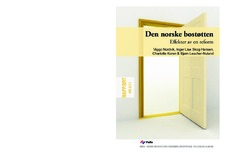| dc.description.abstract | The aim of the Norwegian Housing Allowance is to enable low-income households to increase, or maintain, their housing consumption. The Housing Allowance is based on a “gap” notion; for households entitled, the allowance is determined as a certain percentage of their housing expenses in excess of what is considered as reasonable. Reasonable housing expenses increases with the household income, and there is an upper limit to eligible expenses, depending on size of family. Implicitly, this determines income limits for households that may receive the benefit. The Housing Allowance was reformed in 2009. While it preciously was reserved for families with children, old age and disability pensioners, and certain long term recipients of social welfare, now all types of low-income households may be entitled. Additionally, there previously were also certain conditions on the size and type and ownership of dwelling, now most dwellings are accepted. As part of the reform, the assessment of reasonable housing expenses and upper limits were revised, with the particular aim to make more families with many children eligible. In this Research Report we present an evaluation the reform after one year’s experience with the new legislation. We discuss whether the reform has reached its housing policy aims and study the distributive effect of the reform. We have analyzed administrative register data, from The Norwegian National Housing bank, comparing the composition of recipients before and after the reform. We have also conducted a qualitative survey, interviewing administrators and politicians in a selection of municipalities. Administrative registers show that 124.142 households were recipients of the Housing Allowance in May 2009, an increase by 15.1 per cent from May 2009. We conducted simulations on register data, combining data from 2010 with the pre-reform legislation, and found that 24 000 of the recipients in 2010 would not have been entitled to the allowance the previous year. A majority of these households were categorized as other households, and many of them were tenants in privately owned dwellings. Our interpretation is that the reform actually has helped many the households it was aimed at, for example men 25 to 50 years, non-pensioners without children, and with low labour marked involvement. Contrary to the aims of the reform, however, we find only a small rise in the number of families with many children. The maximum income limits for eligibility are still somewhat below the poverty lines, so we cannot expect the Housing Allowance to close the poverty gap. The allowance redistributes income to household with very low income. Our calculations show that the allowance reduced the poverty gap with 16.1 per cent before the reform, and 16.9 per cent after the reform. Informants from all municipalities were we did our interviews reported that expenses on social assistance had been reduced. The Housing Allowance replaced social assistance for many recipients who had earlier not been entitled to housing allowances. Many municipalities offer rental housing to low income groups, preferably on a temporary basis. An increase in housing allowance from central government helps the tenants pay their rent, thus decreases the economic risk for local government. This should in theory increase the supply of municipal housing, but none of our interviewees reported plans for increased municipal housing. There are incentives for the tenants to stay in municipal housing, as the housing allowance is somewhat higher there than in other tenures of housing. Before the reform, municipal tenants could lose the allowance if they rented a privately owned dwelling, now all housing is treated equally. We find that in 2009 the turn-over among tenants in municipal housing was 1.25 per cent, and it fell to 0.9 per cent in 2010. How can the Housing Allowance scheme be improver further? We conclude that the allowance has no great flaws, is a good measure to help low income groups to decent housing, but that it can be improved by expanding its costs. To strengthen low income households’ situation and reduce poverty, the allowance should be increased and still more families should be entitled to it. | en |
